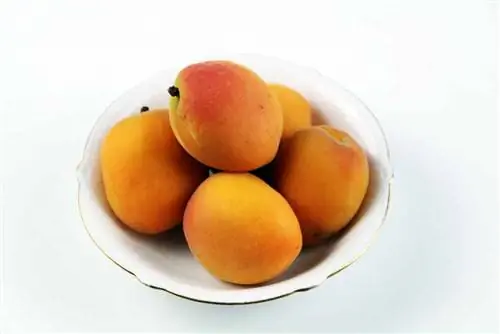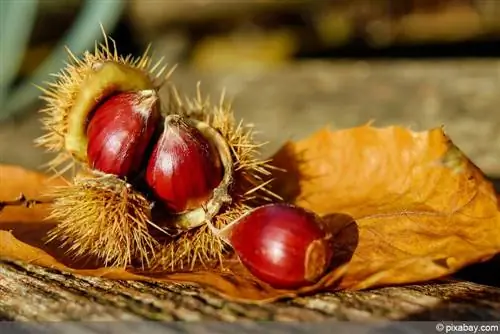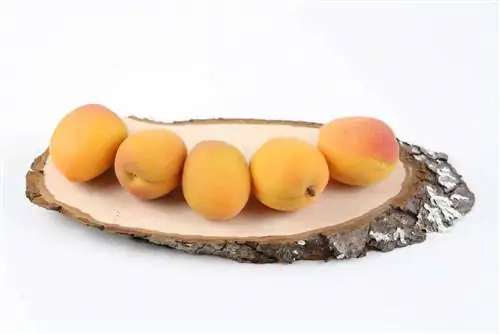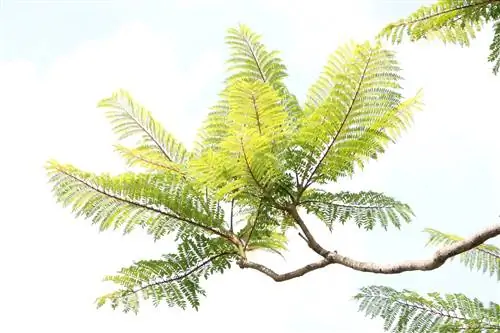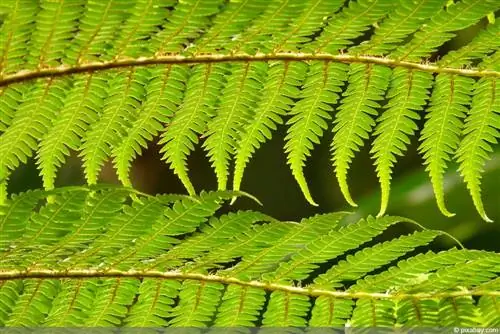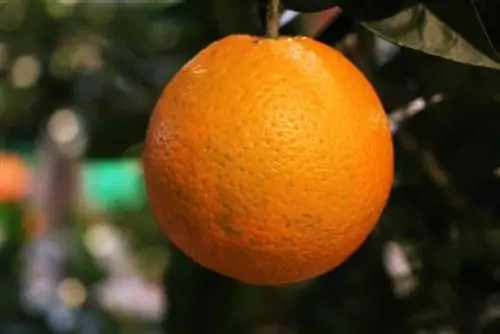- Author admin [email protected].
- Public 2023-12-17 03:39.
- Last modified 2025-01-24 12:45.
The apricot tree has the botanical name Prunus armeniaca and originally comes from China, from where it has spread all over the world. The tree is relatively easy to care for, but only thrives with the right location conditions. Due to the cooler temperatures in the home gardens, a location with a southern exposure and lots of hours of sunshine is particularly suitable. The sensitive apricot tree requires additional protection in winter.
Location
The apricot tree has its origins in warm countries, which is why the tree does not tolerate the local, often cold temperatures particularly well. The plant is also known as the apricot tree and is mainly grown in the warm regions of the Mediterranean. Therefore, the plant depends on the correct selection of the location and also needs additional protective measures. Cultivation is also possible in areas further north, for example in a sheltered valley with a mild climate. The warmer the location, the richer the harvest of sweet fruits. The plant is very sensitive to late frosts because it sprouts early with the first strong rays of sunshine in spring. During this time, the apricot tree should receive sun protection to delay budding and flowering.
- Prefers warm locations with lots of hours of sunshine
- A south-facing slope protected from bad weather is ideal
- Grows particularly well in the local wine-growing regions
- Does not tolerate sustained drafts
- Distance to the house should be at least 4-6 m
- In cooler and mountainous areas, it is better to cultivate in a container
- Also suitable as espalier fruit on the southern wall of the house
Planting substrate
In addition to the location, the planting substrate also plays an important role in ensuring that the apricot tree produces a good harvest. If the soil is extremely loamy and clayey, it will accumulate rain and irrigation water and thereby damage the sensitive tree. In addition, sufficient oxygen supply to the roots is important so that the tree can develop well on the surface. Constantly wet clay soil suffocates the sensitive roots over time. Therefore, drainage should be created to make the soil more permeable to water.
- Light soils with sandy parts are ideal
- Soil pH value should be neutral, around 7
- Ensure good permeability
- Regularly loosen up loamy soils
- Create drainage below the root ball
- Working in coarse gravel or gravel is ideal
Plants
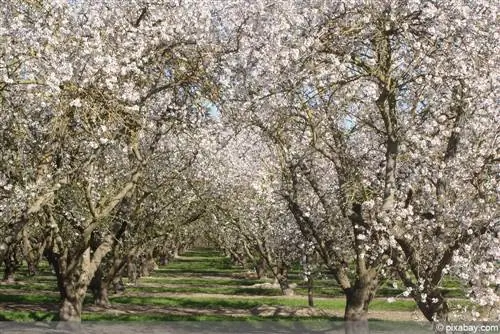
When planting the apricot tree, the specimen should not be older than one year. Significantly older trees are difficult to transplant and tolerate this process very poorly. Ideally, the young plant is purchased in a container so that the root system can develop sufficiently. These trees are much more robust and get used to their new location quickly and easily. Plus, they can be planted almost any time of the year. On the other hand, bare-root apricot trees should only be left in the garden from October to April. In order to be able to expect a harvest at the end of summer, it is advisable to plant at the beginning of spring so that the tree has enough time to develop flowers.
- Plant after the last hard winter frost
- The best time is in spring, from March
- Thoroughly loosen the soil
- Remove old roots, larger stones and weeds
- Carefully pull the root ball apart
- Place in a water bath so that the roots can soak up
- Create drainage below the roots
- Dig out a planting hole twice as large as the root ball
- Enrich one third of the planting site with compost
- Mix in the horn shavings
- Place the young plant upright in the middle
- When digging in, press the potting soil down well from time to time
- Leave the grafting point about 5 cm above the ground
- Then water generously
Watering & Fertilizing
As a fruit tree, the Prunus armeniaca thrives primarily in a dry and warm climate, which is interrupted by occasional downpours. The apricot tree does not tolerate prolonged moisture well and reacts to it with falling leaves and a lack of flowers and fruit. That's why watering and fertilizing in the local areas is particularly important, as is protection from bad weather. It is also a good idea to create a warming layer of mulch; this way, the water balance can be better maintained in a he althy balance. Normally the prevailing rainfall is completely sufficient, especially for older specimens with deep roots. If there is a longer dry phase in the hot summer months, then young plants in particular are dependent on additional watering.
- Keep plant substrate only moderately moist
- Water only if it is dry for a long time
- Watere more frequently during hot summer periods
- Only water when the soil surface is dry
- Does not tolerate lime well, neither in the soil nor in irrigation water
- Collected rainwater is ideal
- Descale tap water before watering
- Fertilize every 4 weeks from March to July
- Organic fertilizers are optimal
- Bluecorn can be administered in spring
- Lay out a mulch layer of bark mulch, leaves or grass clippings
Tip:
If the apricot tree is cultivated in a bucket, the water requirement is generally greater and the plant urgently needs additional watering.
Cutting
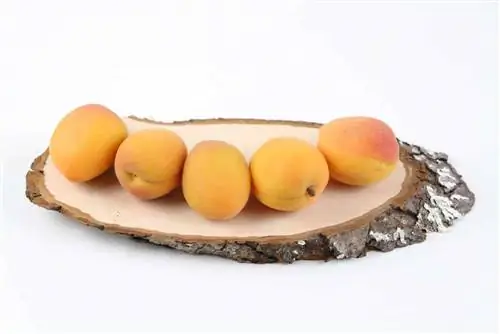
Just like other fruit trees, the apricot tree needs to be pruned. This is the only way to guarantee that the leaves, flowers and fruits receive sufficient sunlight and that air circulation is not blocked. Severe pruning is not necessary; the crown should be thinned out carefully so as not to weaken the plant too much. The best time to prune is immediately after harvest, this way the tree has enough time to recover before the first nights of frost. In this context, it is also important to remove broken and injured branches. These are often caused by weather damage or are nibbled on by animals. Such injuries pose a risk of infection. Only high-quality cutting tools should be used for pruning so as not to crush the branches unnecessarily.
- Remove shoots that compete with the leader in the first two years
- Remove all dead wood annually
- Cut off shoots that grow too inwards
- Cut vertically aligned branches, the so-called water shoots
- Always cut just above an outward-facing eye
- In general, cut at a slight angle
- Use sharp and disinfected cutting tools
- Remove broom-shaped shoots at the base of the tree
- Treat larger cuts as a precaution with tree resin
Wintering
Although the apricot tree is extremely hardy, frost temperatures are dangerous for the flowers. These often sprout very early at the end of winter or the beginning of spring and do not survive temperatures below freezing. For this reason, late frosts pose a great danger to the crop. Extremely cold temperatures during the winter months do not harm the apricot tree, but intense winter sun is harmful. The tree forms a shiny bark, which forms unsightly cracks due to strong sunlight combined with sub-zero temperatures. Therefore, the trunk should be given appropriate protection measures in winter to prevent this blemish. If there is little snow or rain in the winter months, the plant depends on additional watering.
- Withstands sub-zero temperatures down to -30° C
- Shade at the beginning of spring so that the flowers don't die out too early
- In case of late frosts, cover branches with protective fleece
- Lay out mulch film, leaves or straw in the root area as heat protection
- Lean wooden slats diagonally against the trunk to prevent damage to the bark
- Water occasionally during dry periods without snow or rain
- Potted plants move to bright and frost-free winter quarters before the first frosts
- Water occasionally, but only when the top layer of soil is dry
- Check periodically for diseases and pests
Diseases & Pests
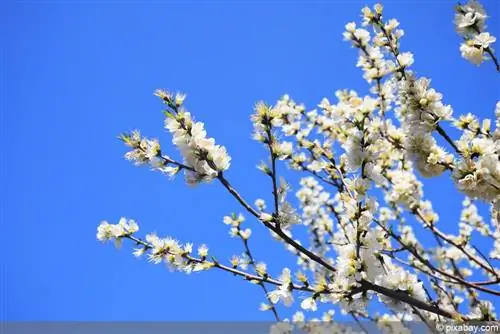
If the apricot tree's immune system is compromised, diseases and pests often occur. The cause can be long-term waterlogging, as well as a lack of protective measures in winter and at the beginning of spring. The better the site conditions and winter protection, the more resilient the plant is. It is important to have regular checks, which should be carried out all year round.
- Eaten and holey leaves and fruits indicate frost moth
- Collect butterfly caterpillars by hand
- Preparations with Bacillus Thuringiensis are helpful
- Discolored and blistered leaves are signs of curl disease
- Fungus causes the fruits and leaves to die
- Fight with spray containing copper, starting in January
- In extreme cases, completely remove all affected branches, leaves and fruits
- Shotgun disease causes round leaf spots and holes
- Apply fungicides in wet weather conditions
- Use biologically safe preparations
- This includes copper, net sulfur, Stulln and clay
- Bacterial blight causes brown spots on the edges of leaves
- Prevent with regular whites
- Inject copper-containing solutions early on

